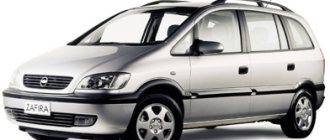Car history
In total, the Mitsubishi Pajero Sport line includes as many as 3 generations, produced since 1996.
1st generation, 1996-2010
Years of production are 1996, 1997, 1998, 1999, 2000, 2001, 2002, 2003, 2004, 2005, 2006, 2007, 2008, 2009 and the last production year is 2010.
The car was supplied to the CIS countries with a petrol 3.0 V6 and a 2.5 liter turbodiesel with 85 hp. There were also 3.5 liter gasoline engines and 2.8 and 3.2 liter turbocharged diesel engines. In just 14 years of production, 630 thousand first-generation Pajero Sport cars were produced.
2nd generation, 2008-2016
Years of production: 2008, 2009, 2010, 2011, 2012, 2013, 2014, 2015, 2021.
Unlike the first version, the car began to look more modern, larger and richer. In the period from 2013 to 2015, the car was also assembled at the Kaluga plant, where the frames were produced by the Gorky plant. The “arsenal” offered to buyers included a 2.5-liter gasoline engine with 178 hp. and manual/automatic transmission. Petrol V6 3.0 l. along with the machine gun. There was also a 3.2 liter diesel. at 220 hp
In 2013 and 2014, the car underwent a restyling of its appearance. The complete cessation of production occurred in 2016. Over the entire period, 400 thousand copies were made.
3rd generation, 2015
Production years 2015, 2021, 2021, 2021.
Buyers are offered a 2.4 liter turbodiesel (181 hp) paired with a manual transmission and a 3.0 liter V6 petrol (209 hp).
Mitsubishi Pajero Sport engine - how much oil to fill
First generation K90, 1996-2010
The 1996 Pajero Sport was considered an affordable alternative to the flagship Pajero model. At the same time, the car was no less impressive in its cross-country ability – largely thanks to the frame structure from the L200 pickup. The car borrowed from him a shortened chassis with an independent torsion bar suspension at the front and rear springs. In the “base” the car was equipped with a proprietary transmission with a rigid connection to the front wheels.
However, versions with permanent all-wheel drive were supplied to Japan and the USA. The first generation of Pajero Sport has received many improvements during its production life. So, during the next modernization in 2000, the car received a spring rear suspension (instead of a leaf spring). In Russia, the SUV was offered with a 2.5 diesel engine (85 hp) and a 3.0 liter six-cylinder petrol engine. In addition, in other countries the 3.5-liter V6 version was still relevant, as well as 2.8 and 3.2 liter turbocharged diesel engines.
Also read: Motor oil for Toyota Carina engine
Gasoline engines 1998-2008
3.0 170 l. With. (6G72), oil volume - 4.9 liters, tolerance and viscosity: API-SG, SH, SJ, SL; SAE 5W-40, 0W-40, 0W-30, 10W-40, 10W-30
Diesel engines 1998-2008
2.5 100 l. With. (4D56), oil volume - 5.6 liters, tolerance and viscosity: API-CE, CF-4, CF, CG, CG-4, CH, CH-4, CI; SAE 5W-40, 0W-40, 0W-30, 10W-30, 10W-40
Second generation KH0, 2008-2017
The second Pajero Sport has become larger and more impressive than its predecessor. In terms of equipment, the car has become more advanced, which has a negative impact on the cost. As a result, the more expensive SUV was closer in price to the flagship Pajero, but still remained popular. The design of the model still showed the brutal features of its predecessor.
The car received a frame chassis from the 4th generation L200 pickup truck, and also had permanent all-wheel drive and center/rear differential locks. A function was also available to disable the front wheel drive to reduce fuel consumption - for example, in urban conditions. The car was delivered to Russia with a base 2.5 liter diesel engine (178 hp), working with a manual or automatic transmission. The top version received a 3.0 liter petrol “six” (220-222 hp), which was only available with an automatic transmission.
Until 2011, Pajero Sport was available with a top-end 200-horsepower 3.2-liter diesel engine. In the Russian version, the car was offered with a five-seater interior and all-wheel drive, while some other countries were supplied with cars with a 7-seat interior and rear-wheel drive. In 2013, restyling took place. Then the SUV received an improved design, and a year later a new front panel with a more functional audio system appeared on the equipment list. Production of the 2nd generation Pajero Sport continued until 2021. A total of 400 thousand copies were produced.
Gasoline engines 2008-2017
- 3.0 220 l. With. (6B31), oil volume - 4.3 liters, tolerance and viscosity: API-SL, SM; SAE 5W-40, 10W-40, 0W-30, 0W-40, 10W-30
- 3.0 222 l. With. (6B31), oil volume - 4.3 liters, tolerance and viscosity: API-SL, SM; SAE 5W-40, 10W-40, 0W-30, 0W-40, 10W-30
Also read: Engine oil for Toyota Land Crusier Prado 150 engine
Diesel engines 2008-2017
- 2.5 178 l. With. (4D56), oil volume - 5.6 liters, tolerance and viscosity: API-CI, CI-4; SAE 5W-40, 10W-40, 10W-30, 0W-30, 0W-40
- 3.2 163 l. With. (4M41), oil volume – 9.3 liters, tolerance and viscosity: API-CI, CI-4; SAE 5W-40, 10W-40, 10W-30, 0W-30, 0W-40
Third generation KS0W, since 2016
The third generation Pajero Sport has a frame design from the L200 pickup. The car also has an original design of the front and rear of the body, designed in the style of the Dynamic Shield design concept, the key feature of which is the X-shaped design at the front. In addition, let's take a look at the shape of the rear lights, which are reminiscent of those of the 2013 GR-HEV concept car. In the Asia-Pacific region, the 3rd generation Pajero Sport is a competitor to the Chevrolet TrailBlazer, Toyota Fortuner and Ford Everest. In 2021, the car entered the Russian market, where it became available in three modifications. Engines are a 3.0 liter petrol six (209 hp), as well as a 180-horsepower 2.4 liter diesel engine. Initially, the car was supplied from abroad, and in November 2017, production began in Kaluga. The Russian version of Pajero Sport III has permanent all-wheel drive and two types of gearbox – manual and automatic.
Gasoline engines since 2016
3.0 209 l. With. (6B31), oil volume – 4.3 liters, tolerance and viscosity: API-SM, SN; SAE 5W-40, 0W-40, 0W-30, 10W-30, 10W-40, 5W-30
Diesel engines from 2017
2.4 181 l. With. (4N15), oil volume - 8.3 liters, tolerance and viscosity: API-CI-4, CJ, CJ-4; SAE 5W-40, 0W-40, 0W-30, 10W-30, 10W-40, 5W-30
Changing the engine oil
The engine oil replacement period (together with the oil filter) should be 15 thousand km or one year, whichever comes first for a particular unit. To make the replacement process go quickly, it is better to have an assistant with you. Before work, you need to remove the engine protection.
What kind of oil to pour and how much
The Mitsubishi Pajero Sport 3.0 (V6) engine is filled with 4.5 liters of 5W40 synthetic oil from the factory. The original oil filter can be found under catalog number MZ690150.
For a 2.5 liter engine, 5W40 is poured in the amount of 2.4 liters. For example, this could be ZIC XQ LS Fully Synthetic. Oil filter – Knecht (Mahle Filter) OC 274.
For a 3.2 liter turbodiesel, 0W40 engine oil and filter 1230A046 are suitable.
The amount of engine oil directly depends on the engine assembly (configuration):
- Engine 6B31 (3.0 liters) – 4.3 liters.
- Engine 4D56 (2.5 liters, diesel) – 6.4 liters.
- Engine 4M41 (3.2 liters, diesel) – 9.3 l.
How to change
- To replace, you need to warm up the engine at idle speed.
- Remove the protection under the engine.
- We grind off the used oil through the drain plug.
- We replace the oil filter with a new one.
- We tighten the drain plug.
- Fill in new oil in the required quantity.
What oil is required for the Mitsubishi Pajero Sport engine
Original
For Mitsubishi Pajero Sport with a gasoline engine, the original Mitsubishi Oil 0W-30 art MZ320151 or Mitsubishi Oil 0w-20 art MZ320191 engine oil is recommended. For diesel engines - Mitsubishi Diesel Oil 5W-30 art 320759. The indicated fluidity may vary, because it is selected depending on the climatic conditions in which the car is operated. For example, if you drive only in the hot season, then “summer” oil with a viscosity of 20W-40 or 25W-50 is recommended. For winter operation, 0W-40, 0W-30 or 5W-30 is more suitable, and for year-round trips, you can opt for all-season oil with parameters 10W-40, 10W-30 or 0W-40.
Also read: Engine oil for Peugeot 406 engine
Unoriginal
If the car is far from new, has no warranty or has a high mileage, then it makes sense to use a relatively inexpensive analogue oil from trusted brands such as Shell, Castrol, Valvoline, Motul, Liqui Moly, Mobil, etc.
In addition, such a liquid must meet the characteristics specified for the original oil. Among them, we highlight the appropriate API tolerance, which is selected based on the temperature conditions in which the car is located most of the time. For example, for a petrol SUV Pajero Sport model 1996. All-season semi-synthetics with parameters 10W30 and API-SG are suitable, and for diesel engines - API-CE or CF-4. For gasoline cars of later years, for example, 2008, semi-synthetics with API-SL approval are recommended.
For diesel engines - API-CH-4 or CI. As for the second generation Pajero Sport, released in 2009, all-season semi-synthetic 10W-40 API-SL is suitable for this car with a gasoline engine, and API-CI for diesel engines. For gasoline versions of later years (for example, 2014), you can use pure API-SM synthetics. For diesel engines - API-CI-4. And finally, we will determine the suitable lubricant for the 2015 petrol Pajero Sport. (third generation) is an all-season 10W-40 synthetic with API-SM or API-SN approval for cars produced in 2021. For diesels, CI-4, CJ or CJ-4 is suitable. Below are the best analogue engine oils for Mitsubishi Pajero Sport.
- Shell Helix Diesel Ultra 5W-40 art 550040558
- Castrol Edge Titanium 5W-30 art 15669A
- Motul 8100 X-Clean 5W-30 art 106377
- Liqui Moly 5W-30 Top Tec art 7661
Changing automatic transmission oil
The manufacturer recommends replacement every ~ 60-90 thousand km.
There is a complete and partial replacement of transmission fluid. The manufacturer recommends filling the “five-speed” – Pajero Sport II Mitsubishi ATF SP II, into the eight-speed automatic transmission Pajero Sport III Mitsubishi ATF SP III.
How to change
- Warm up the engine at idle speed.
- We unscrew the drain plug of the box and drain the waste liquid into a previously prepared container with the volume of the amount being filled.
- Remove the box tray and wash the filter.
- We clean the magnets from chips and metallic dust (at the bottom of the tray).
- We put the new automatic transmission filter in its place.
- We install the pallet in place. If necessary, replace the gasket.
- We tighten the drain plug.
- We fill in new transmission fluid through the technological hole.
- We check the level using the dipstick (which is in the box).
- After driving 10 km, we check the automatic transmission level again.
Fuel consumption per 100 km
The following are the data on the scheme - engine, transmission type and consumption in liters.
Pajero Sport 1
- Diesel 2.5 l, (115 hp), manual transmission all-wheel drive (4WD) – 10.0
- Diesel 2.5 l, (99 hp), manual transmission (4WD) – 10.1
- Diesel 2.5 l, (133 hp) Manual transmission (4WD) – 10.4
- Gasoline 3.0 l, (177 hp) Automatic transmission (4WD) – 13.2
- Gasoline 3.0 l, (177 hp) Manual transmission (4WD) – 13.5
- Gasoline 3.0 l, (170 hp) Manual transmission (4WD) – 12.3
- Diesel 2.5 l, (100 hp) Manual transmission (4WD) – 12.6
- Gasoline 3.0 l, (170 hp) Automatic transmission (4WD) – 13.3
2008-2016
- Gasoline 3.0 l (220 hp) Automatic transmission (4WD) – 12.3
- Diesel 2.5 l (178 hp) Manual transmission (4WD) – 8.2
- Diesel 2.5 l (178 hp) Automatic transmission (4WD) – 9.4
- Diesel 3.2 l (163 hp) Manual transmission (4WD) – 7.9
- Diesel 3.2 l (163 hp) Automatic transmission (4WD) – 7.9
What oil to use for Mitsubishi Pajero Sport
Original
Transmission oil on a mineral, semi-synthetic or synthetic basis is poured into the rear axle gearbox and transfer case of the Mitsubishi Pajero Sport SUV. For the gearbox, Mitsubishi Motors Genuine Super Hypoid Gear Oil is recommended, and for the transfer case, Mitsubishi Motors Genuine MTF or Multi Gear Oil is recommended. For cars of recent years of production, semi-synthetic or synthetic is recommended. As for viscosity, SAE 70W, 80W or 85W is suitable for winter use, and SAE 90, 140 or 250 is used mainly in summer. In Russian operating conditions, the most popular is multi-grade oil with SAE 75W-80, 80W-85, 80W-90 or 75W-90.
Unoriginal
Before purchasing suitable oil for the transfer case, gearbox and axles of the Mitsubishi Pajero Sport SUV, you need to pay attention to several important factors. Firstly, this is the choice of a manufacturer with a good reputation: Mannol, Total, Eneos, ZIC, Castrol, Kixx, etc. Secondly, regarding the type of viscosity: synthetic oil is more fluid, suitable for cars of recent years of production. Accordingly, mineral water or semi-synthetics are recommended for older cars. It has a relatively thick consistency, which means there is less chance of leaks in the presence of microcracks or gaps between contact pairs. Thirdly, when choosing an oil, they also pay attention to the current tolerance indicators API-GL-3, 4 or 5. The higher the indicator, the more oil additives. For the Mitsubishi Pajero Sport of the first years of production, AP-GL-3 or 4 will be sufficient, and for cars of the latest generations, API-GL-5 will be suitable. Below are suitable oils for the gearbox, axles and transfer case of the Mitsubishi Pajero Sport SUV.
Also read: Automatic transmission oil for Mitsubishi Outlander
Transfer case oil: Liqui Moly Hochleistungs-Getriebeoil 75W-80
Rear/front axle gearbox oil: Totachi Extra Hypoid GL-5/MT-1 80W-90.






